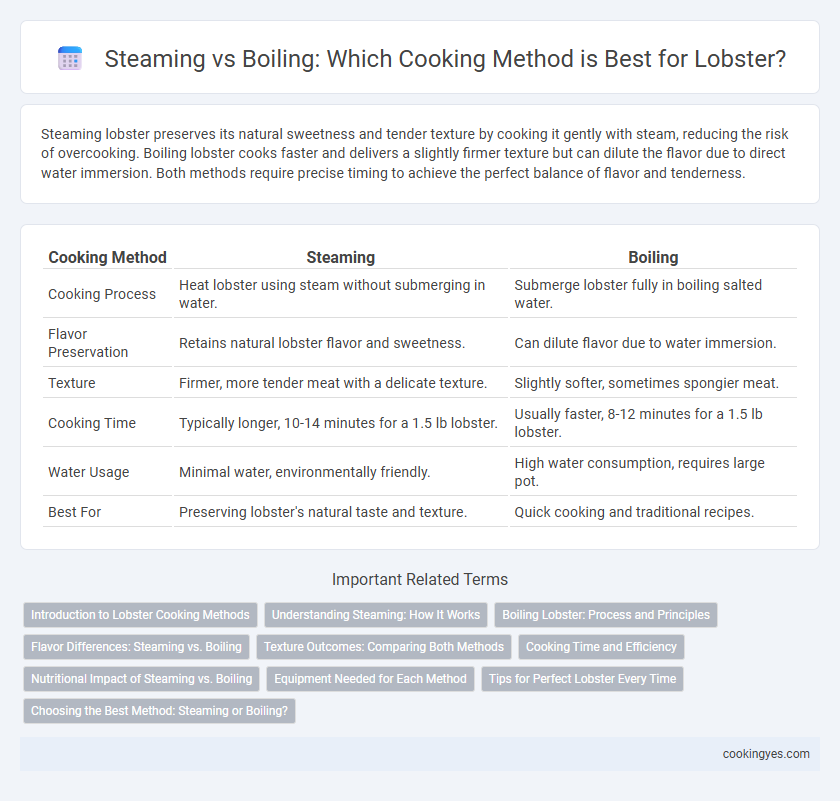Steaming lobster preserves its natural sweetness and tender texture by cooking it gently with steam, reducing the risk of overcooking. Boiling lobster cooks faster and delivers a slightly firmer texture but can dilute the flavor due to direct water immersion. Both methods require precise timing to achieve the perfect balance of flavor and tenderness.
Table of Comparison
| Cooking Method | Steaming | Boiling |
|---|---|---|
| Cooking Process | Heat lobster using steam without submerging in water. | Submerge lobster fully in boiling salted water. |
| Flavor Preservation | Retains natural lobster flavor and sweetness. | Can dilute flavor due to water immersion. |
| Texture | Firmer, more tender meat with a delicate texture. | Slightly softer, sometimes spongier meat. |
| Cooking Time | Typically longer, 10-14 minutes for a 1.5 lb lobster. | Usually faster, 8-12 minutes for a 1.5 lb lobster. |
| Water Usage | Minimal water, environmentally friendly. | High water consumption, requires large pot. |
| Best For | Preserving lobster's natural taste and texture. | Quick cooking and traditional recipes. |
Introduction to Lobster Cooking Methods
Steaming lobster preserves its natural sweetness and tender texture by cooking gently with boiling water vapor, minimizing nutrient loss and water absorption. Boiling lobster submerges it completely in salted water, ensuring even cooking but potentially diluting flavor and texture due to direct contact with water. Choosing between steaming and boiling depends on desired taste, texture, and cooking time, with steaming favored for enhanced flavor retention and boiling preferred for speed and simplicity.
Understanding Steaming: How It Works
Steaming lobster involves cooking the shellfish with moist heat generated from boiling water, which gently cooks the lobster while preserving its natural flavors and texture. This method allows for even heat distribution and minimizes nutrient loss compared to boiling, where the lobster is fully submerged. Understanding steaming mechanics highlights its advantage in maintaining lobster's firmness and sweetness by preventing direct contact with boiling water.
Boiling Lobster: Process and Principles
Boiling lobster involves submerging the crustacean in rapidly boiling salted water, ensuring even heat distribution for a thoroughly cooked, tender meat texture. The process requires maintaining a rolling boil, properly timing the cooking based on lobster size--typically 8 to 12 minutes per pound--to prevent overcooking and preserve flavor. Using sea salt in the water mimics the lobster's natural habitat, enhancing the meat's natural sweetness and briny taste.
Flavor Differences: Steaming vs. Boiling
Steaming lobster preserves its natural sweetness and tender texture by gently cooking the meat without direct contact with water, resulting in a more robust and delicate flavor profile. Boiling lobsters often leads to a slightly diluted taste as the meat absorbs some of the saline water, giving a saltier but less nuanced flavor. Choosing steaming over boiling highlights the lobster's fresh oceanic essence, making it the preferred method for flavor-conscious cooking.
Texture Outcomes: Comparing Both Methods
Steaming lobster preserves a firmer texture by cooking the meat gently with hot vapor, preventing overhydration and maintaining its natural succulence. Boiling lobster immerses the shellfish in rapidly boiling water, which can sometimes result in a softer, slightly waterlogged meat texture due to direct contact with water. Choosing steaming often yields more tender yet structured lobster meat, while boiling may offer a milder, more uniform tenderness depending on cooking time.
Cooking Time and Efficiency
Steaming lobster typically requires 10-20 minutes depending on size, preserving delicate flavors through gentle heat and minimal water contact. Boiling lobster cooks slightly faster, usually within 8-15 minutes, due to direct water immersion and higher heat transfer. Steaming offers efficiency for smaller quantities, while boiling suits larger batches with quicker cooking time but risk of flavor dilution.
Nutritional Impact of Steaming vs. Boiling
Steaming lobster preserves more water-soluble vitamins such as B vitamins and minerals by minimizing nutrient leaching into cooking water, compared to boiling where nutrients can be lost into the boil water. The gentler temperature of steaming reduces protein denaturation and retains more omega-3 fatty acids, enhancing the lobster's overall nutritional value. Therefore, steaming is a preferred cooking method to maximize the retention of essential nutrients in lobster meat.
Equipment Needed for Each Method
Steaming lobster requires a large pot with a steaming rack or basket to keep the lobsters above the boiling water, ensuring even heat distribution without submerging them. Boiling lobster necessitates a pot large enough to fully immerse the lobsters in salted, boiling water for uniform cooking. Both methods require a heat source compatible with the pot size and a timer to monitor precise cooking durations.
Tips for Perfect Lobster Every Time
Steaming lobster retains more flavor and results in a tender texture by cooking it gently with steam surrounding the shell. Boiling is faster but can dilute the lobster's natural sweetness due to direct water immersion. To achieve perfect lobster every time, use fresh lobsters, ensure water or steam temperature is consistent at 212degF (100degC), and cook lobsters for 7-14 minutes depending on weight.
Choosing the Best Method: Steaming or Boiling?
Steaming lobster preserves more flavor and texture by cooking the meat evenly without direct contact with water, resulting in a tender and juicy taste. Boiling is faster and can cook lobsters more thoroughly but may dilute the natural sweetness of the meat due to prolonged water exposure. For optimal flavor retention and delicate texture, steaming is generally considered the best method for cooking lobster.
Steaming vs Boiling for lobster cooking methods Infographic

 cookingyes.com
cookingyes.com